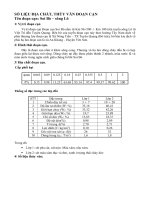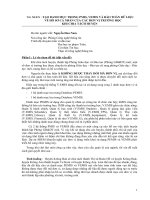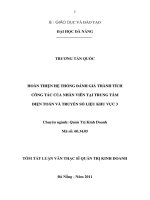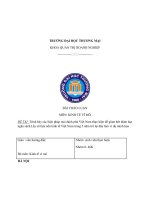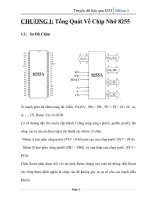Ch6 1 v1 TRUYỀN SỐ LIỆU VÀ MẠNG
Bạn đang xem bản rút gọn của tài liệu. Xem và tải ngay bản đầy đủ của tài liệu tại đây (1.1 MB, 56 trang )
Chapter 6
Bandwidth Utilization:
Multiplexing and
Spreading
6.1
Copyright © The McGraw-Hill Companies, Inc. Permission required for reproduction or display.
Note
Bandwidth utilization is the wise use of
available bandwidth to achieve
specific goals.
Efficiency can be achieved by
multiplexing; i.e., sharing of the
bandwidth between multiple users.
6.2
6-1 MULTIPLEXING
Whenever the bandwidth of a medium linking two
devices is greater than the bandwidth needs of the
devices, the link can be shared. Multiplexing is the set
of techniques that allows the (simultaneous)
transmission of multiple signals across a single data
link. As data and telecommunications use increases, so
does traffic.
Topics discussed in this section:
Frequency-Division Multiplexing
Wavelength-Division Multiplexing
Synchronous Time-Division Multiplexing
Statistical Time-Division Multiplexing
6.3
Figure 6.1 Dividing a link into channels
6.4
Figure 6.2 Categories of multiplexing
6.5
Figure 6.3 Frequency-division multiplexing (FDM)
6.6
Note
FDM is an analog multiplexing technique
that combines analog signals.
It uses the concept of modulation
discussed in Ch 5.
6.7
Figure 6.4 FDM process
6.8
FM
6.9
Figure 6.5 FDM demultiplexing example
6.10
Example 6.1
Assume that a voice channel occupies a bandwidth of 4
kHz. We need to combine three voice channels into a link
with a bandwidth of 12 kHz, from 20 to 32 kHz. Show the
configuration, using the frequency domain. Assume there
are no guard bands.
Solution
We shift (modulate) each of the three voice channels to a
different bandwidth, as shown in Figure 6.6. We use the
20- to 24-kHz bandwidth for the first channel, the 24- to
28-kHz bandwidth for the second channel, and the 28- to
32-kHz bandwidth for the third one. Then we combine
them as shown in Figure 6.6.
6.11
Figure 6.6 Example 6.1
6.12
Example 6.2
Five channels, each with a 100-kHz bandwidth, are to be
multiplexed together. What is the minimum bandwidth of
the link if there is a need for a guard band of 10 kHz
between the channels to prevent interference?
Solution
For five channels, we need at least four guard bands.
This means that the required bandwidth is at least
5 × 100 + 4 × 10 = 540 kHz,
as shown in Figure 6.7.
6.13
Figure 6.7 Example 6.2
6.14
Example 6.3
Four data channels (digital), each transmitting at 1
Mbps, use a satellite channel of 1 MHz. Design an
appropriate configuration, using FDM.
Solution
The satellite channel is analog. We divide it into four
channels, each channel having 1M/4=250-kHz
bandwidth.
Each digital channel of 1 Mbps must be transmitted over
a 250KHz channel. Assuming no noise we can use
Nyquist to get:
C = 1Mbps = 2x250K x log2 L -> L = 4 or n = 2 bits/signal
element.
One solution is 4-QAM modulation. In Figure 6.8 we
6.15
show a possible configuration with L = 16.
Figure 6.8 Example 6.3
6.16
Figure 6.9 Analog hierarchy
6.17
Example 6.4
The Advanced Mobile Phone System (AMPS) uses two
bands. The first band of 824 to 849 MHz is used for
sending, and 869 to 894 MHz is used for receiving.
Each user has a bandwidth of 30 kHz in each direction.
How many people can use their cellular phones
simultaneously?
Solution
Each band is 25 MHz. If we divide 25 MHz by 30 kHz, we
get 833.33. In reality, the band is divided into 832
channels. Of these, 42 channels are used for control,
which means only 790 channels are available for cellular
phone users.
6.18
Figure 6.10 Wavelength-division multiplexing (WDM)
6.19
Note
WDM is an analog multiplexing
technique to combine optical signals.
6.20
